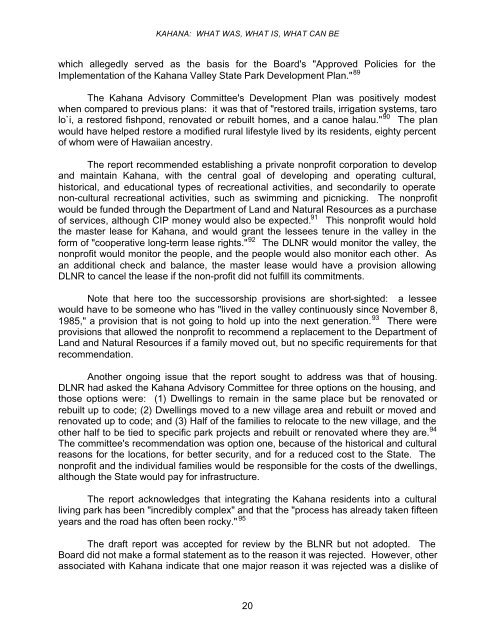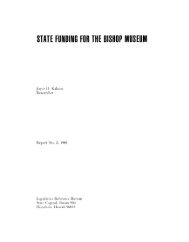Kahana: what was, what is, what can be. - Legislative Reference ...
Kahana: what was, what is, what can be. - Legislative Reference ...
Kahana: what was, what is, what can be. - Legislative Reference ...
Create successful ePaper yourself
Turn your PDF publications into a flip-book with our unique Google optimized e-Paper software.
KAHANA: WHAT WAS, WHAT IS, WHAT CAN BE<br />
which allegedly served as the bas<strong>is</strong> for the Board's "Approved Policies for the<br />
Implementation of the <strong>Kahana</strong> Valley State Park Development Plan." 89<br />
The <strong>Kahana</strong> Adv<strong>is</strong>ory Committee's Development Plan <strong>was</strong> positively modest<br />
when compared to previous plans: it <strong>was</strong> that of "restored trails, irrigation systems, taro<br />
lo`i, a restored f<strong>is</strong>hpond, renovated or rebuilt homes, and a <strong>can</strong>oe halau." 90 The plan<br />
would have helped restore a modified rural lifestyle lived by its residents, eighty percent<br />
of whom were of Hawaiian ancestry.<br />
The report recommended establ<strong>is</strong>hing a private nonprofit corporation to develop<br />
and maintain <strong>Kahana</strong>, with the central goal of developing and operating cultural,<br />
h<strong>is</strong>torical, and educational types of recreational activities, and secondarily to operate<br />
non-cultural recreational activities, such as swimming and picnicking. The nonprofit<br />
would <strong>be</strong> funded through the Department of Land and Natural Resources as a purchase<br />
of services, although CIP money would also <strong>be</strong> expected. 91 Th<strong>is</strong> nonprofit would hold<br />
the master lease for <strong>Kahana</strong>, and would grant the lessees tenure in the valley in the<br />
form of "cooperative long-term lease rights." 92 The DLNR would monitor the valley, the<br />
nonprofit would monitor the people, and the people would also monitor each other. As<br />
an additional check and balance, the master lease would have a prov<strong>is</strong>ion allowing<br />
DLNR to <strong>can</strong>cel the lease if the non-profit did not fulfill its commitments.<br />
Note that here too the successorship prov<strong>is</strong>ions are short-sighted: a lessee<br />
would have to <strong>be</strong> someone who has "lived in the valley continuously since Novem<strong>be</strong>r 8,<br />
1985," a prov<strong>is</strong>ion that <strong>is</strong> not going to hold up into the next generation. 93 There were<br />
prov<strong>is</strong>ions that allowed the nonprofit to recommend a replacement to the Department of<br />
Land and Natural Resources if a family moved out, but no specific requirements for that<br />
recommendation.<br />
Another ongoing <strong>is</strong>sue that the report sought to address <strong>was</strong> that of housing.<br />
DLNR had asked the <strong>Kahana</strong> Adv<strong>is</strong>ory Committee for three options on the housing, and<br />
those options were: (1) Dwellings to remain in the same place but <strong>be</strong> renovated or<br />
rebuilt up to code; (2) Dwellings moved to a new village area and rebuilt or moved and<br />
renovated up to code; and (3) Half of the families to relocate to the new village, and the<br />
other half to <strong>be</strong> tied to specific park projects and rebuilt or renovated where they are. 94<br />
The committee's recommendation <strong>was</strong> option one, <strong>be</strong>cause of the h<strong>is</strong>torical and cultural<br />
reasons for the locations, for <strong>be</strong>tter security, and for a reduced cost to the State. The<br />
nonprofit and the individual families would <strong>be</strong> responsible for the costs of the dwellings,<br />
although the State would pay for infrastructure.<br />
The report acknowledges that integrating the <strong>Kahana</strong> residents into a cultural<br />
living park has <strong>be</strong>en "incredibly complex" and that the "process has already taken fifteen<br />
years and the road has often <strong>be</strong>en rocky." 95<br />
The draft report <strong>was</strong> accepted for review by the BLNR but not adopted. The<br />
Board did not make a formal statement as to the reason it <strong>was</strong> rejected. However, other<br />
associated with <strong>Kahana</strong> indicate that one major reason it <strong>was</strong> rejected <strong>was</strong> a d<strong>is</strong>like of<br />
20
















